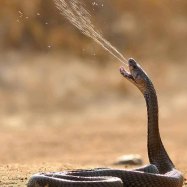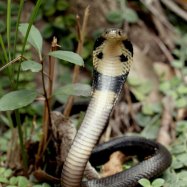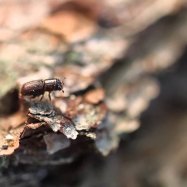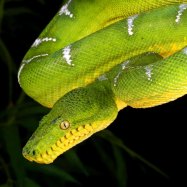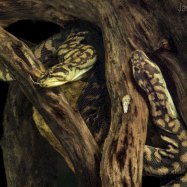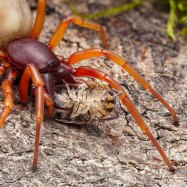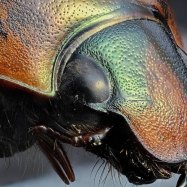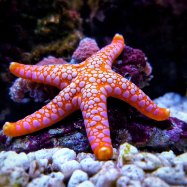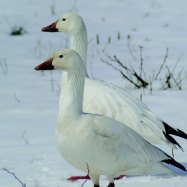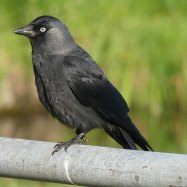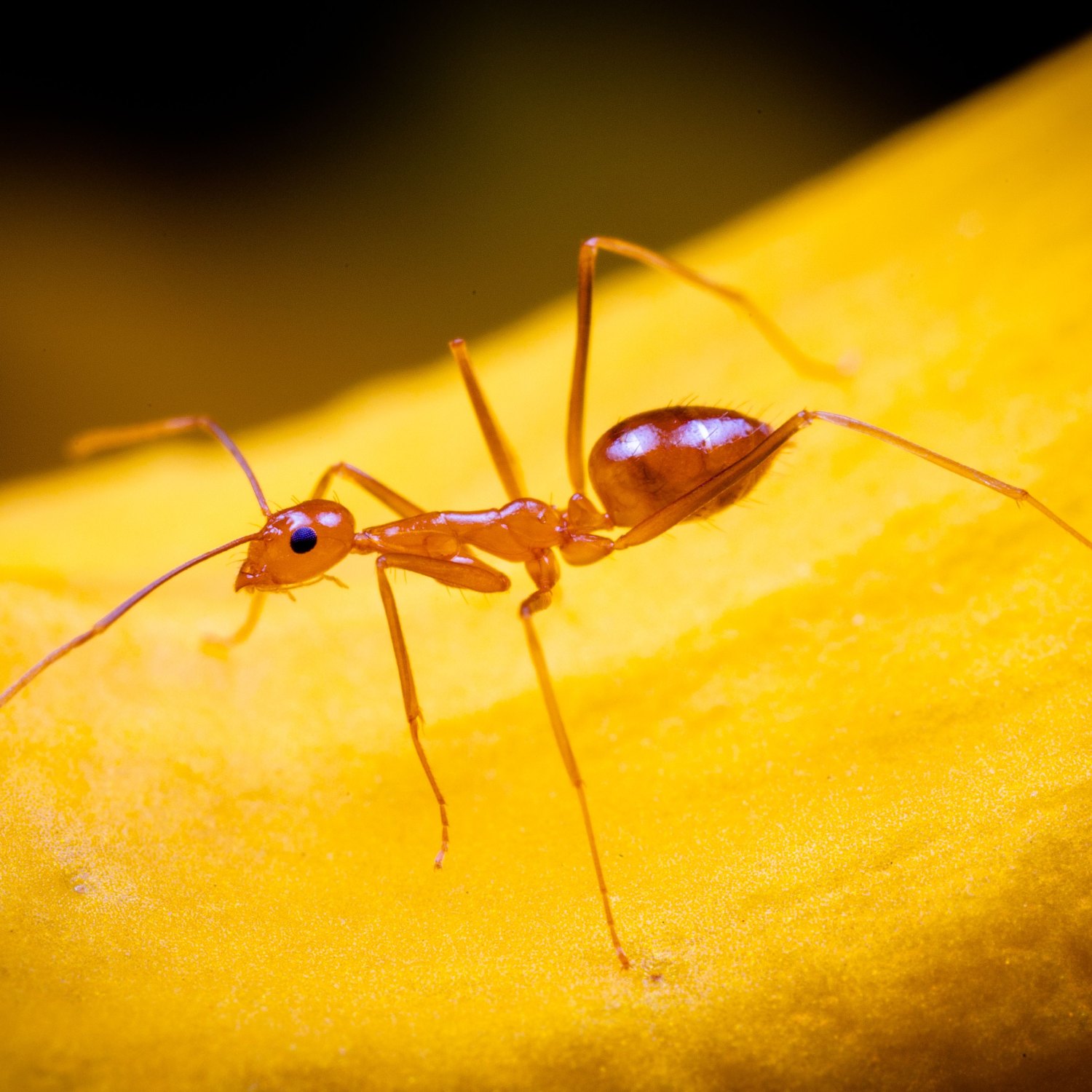
Yellow Crazy Ant
2.5-6 mm
The Yellow Crazy Ant, found in various locations where it has been introduced, belongs to the Formicidae family. This tiny and slender creature measures between 2.5-6 mm in length and is known for its erratic, frenzied movements. Its invasive nature can have detrimental effects on ecosystems, making it important to monitor and control their population. #YellowCrazyAnt #Formicidae #InvasiveSpecies
Animal Details Summary:
Common Name: Yellow Crazy Ant
Kingdom: Animalia
Habitat: Tropical and subtropical areas
The Tiny But Formidable Yellow Crazy Ant: The Invasive Species That's Taking Over the World
In the world of insects, there are countless species that are fascinating and unique in their own way. However, there is one particular species that has gained notoriety for its invasive nature - the Yellow Crazy Ant. Also known as Anoplolepis gracilipes, this small and slender ant has been causing chaos and destruction in the habitats it invades. In this article, we will delve into the world of the Yellow Crazy Ant and discover what makes it such a formidable insect Yellow Crazy Ant.The Basics: Taxonomy and Distribution
Before we dive into the unique characteristics of the Yellow Crazy Ant, let's first get acquainted with its taxonomy and distribution. The Yellow Crazy Ant belongs to the kingdom Animalia, the phylum Arthropoda, and the class Insecta. It is a member of the order Hymenoptera, which includes ants, wasps, and bees, and the family Formicidae, which consists of ants.The Yellow Crazy Ant is native to Africa, Asia, and parts of Australia and Oceania. However, due to human activity, it has been inadvertently introduced to various locations around the world. Its country of origin is still unknown, but it is believed to have originated in Africa.
Habitat and Adaptability
The Yellow Crazy Ant is known for its adaptability and has been able to thrive in a wide range of habitats, which is one of the reasons for its success as an invasive species. Its natural habitat is in tropical and subtropical areas, where it can be found in forests, grasslands, and even urban areas.Unlike most ants, the Yellow Crazy Ant does not build mounds or nests Yellow Fin Tuna. Instead, it forms large colonies under logs, rocks, and other objects on the ground. This makes it difficult to detect and control, as its colonies can go unnoticed for a long time.
Diet and Feeding Method
An interesting characteristic of the Yellow Crazy Ant is its omnivorous feeding behavior. It feeds on a variety of food sources, including insects, small invertebrates, fruits, and seeds. This flexibility in diet allows it to survive in a range of environments, making it a successful invader.One of the reasons why the Yellow Crazy Ant is considered a nuisance is due to its feeding behavior. It forages in large numbers and can quickly strip an area of its food sources, which can have a negative impact on the ecosystem. It has also been known to damage crops and disrupt the balance of the food chain in the areas it invades.
Physical Characteristics
As the name suggests, the Yellow Crazy Ant is predominantly yellow or light brown in color. It has long and slender bodies, measuring between 2.5-6 mm in length. Despite its small size, it is a formidable creature with a painful sting.Its body is divided into three parts - the head, thorax, and abdomen. The head is large and has powerful mandibles, which it uses for both defense and hunting. The thorax is where its six legs are attached, and the abdomen contains its internal organs.
Invasion and Impact
The Yellow Crazy Ant has been unintentionally introduced to various areas around the world, including the United States, Hawaii, and Christmas Island. Its success as an invasive species can be attributed to a few factors. Firstly, it has no natural predators in the areas it invades, which allows it to proliferate rapidly. Secondly, its adaptability and ability to form large colonies make it difficult to control. And finally, it is a highly aggressive species that can outcompete and eliminate other insect species.Invasive species always have a significant impact on the ecosystems they invade, and the Yellow Crazy Ant is no exception. It has been known to wipe out entire populations of other ant species, disrupt the pollination of plants, and even cause bird deaths. In Hawaii, it has been linked to the decline of native bird populations, as it attacks and kills chicks in their nests. Its presence also leads to a decrease in the number of invertebrates, which can have a cascading effect on the entire ecosystem.
Efforts to Control and Eradicate
Due to the destructive nature of the Yellow Crazy Ant, efforts have been made to control and eradicate it in the areas it has invaded. However, these efforts have been challenging, as the ant is resistant to most pesticides and can quickly bounce back from population control. Furthermore, their colonies are often hidden and can span a large area, making it difficult to locate and eliminate them.One of the most successful methods of control has been the use of bait, which is laced with insecticides that are toxic to the Yellow Crazy Ant but not harmful to other species. However, this method requires patience and persistence, as it may take weeks or even months to eliminate the colony fully.
The Future of the Yellow Crazy Ant
Despite efforts to control and eradicate the Yellow Crazy Ant, it continues to thrive in the areas it has invaded. As it has no natural predators and is highly adaptable, it is likely to continue spreading and causing harm to ecosystems around the world.Scientists and researchers are continuously studying this invasive species in hopes of finding new and effective ways to control and eliminate it. Additionally, it is important for the public to be aware of the impact of introducing non-native species and take measures to prevent further invasions.
Conclusion
In conclusion, the Yellow Crazy Ant may seem like a small and harmless creature, but its invasive nature has proven to be a significant threat to ecosystems around the world. Its ability to adapt, form large colonies, and thrive in a range of habitats has made it a formidable species that is difficult to control. As we continue to study and understand this ant, it is crucial to take measures to prevent its further spread and protect our delicate ecosystems from its destructive impact.

Yellow Crazy Ant
Animal Details Yellow Crazy Ant - Scientific Name: Anoplolepis gracilipes
- Category: Animals Y
- Scientific Name: Anoplolepis gracilipes
- Common Name: Yellow Crazy Ant
- Kingdom: Animalia
- Phylum: Arthropoda
- Class: Insecta
- Order: Hymenoptera
- Family: Formicidae
- Habitat: Tropical and subtropical areas
- Feeding Method: Omnivorous
- Geographical Distribution: Africa, Asia, Australia, and Oceania
- Country of Origin: Unknown
- Location: Various locations where it has been introduced
- Animal Coloration: Yellow or light brown color
- Body Shape: Small and slender
- Length: 2.5-6 mm
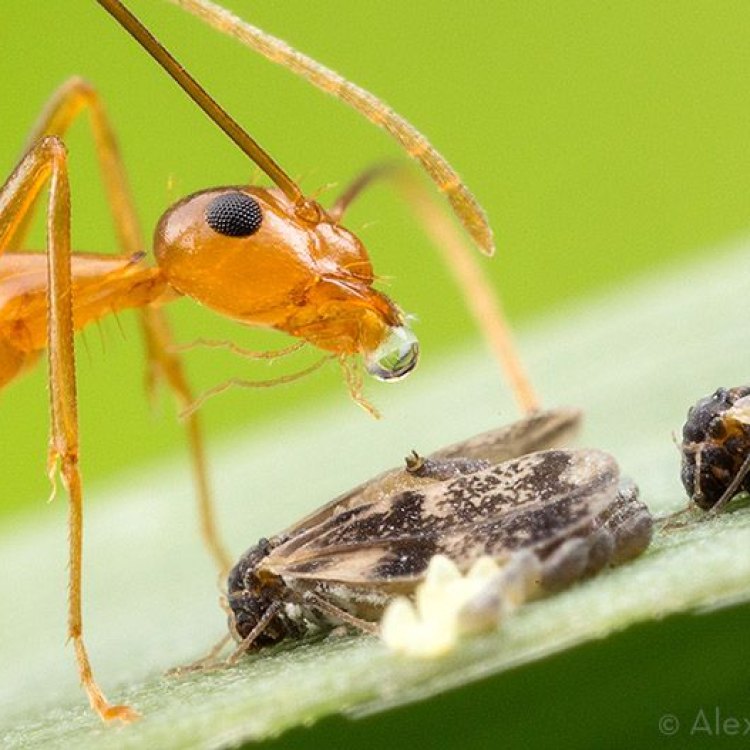
Yellow Crazy Ant
- Adult Size: 2.5-6 mm
- Average Lifespan: 1-3 years
- Reproduction: Reproduces mainly through queens laying eggs
- Reproductive Behavior: Queens establish new colonies by budding
- Sound or Call: No distinctive sound or call
- Migration Pattern: No significant migration pattern
- Social Groups: Highly social, forming large colonies
- Behavior: Aggressive and territorial
- Threats: Ecological disturbance and displacement of native ant species
- Conservation Status: Not evaluated
- Impact on Ecosystem: Can have negative impacts on ecosystems and biodiversity
- Human Use: None
- Distinctive Features: Fast movement, large numbers
- Interesting Facts: Can cause significant damage to ecosystems and can be a household pest
- Predator: Not a top predator, but can prey on small insects and invertebrates
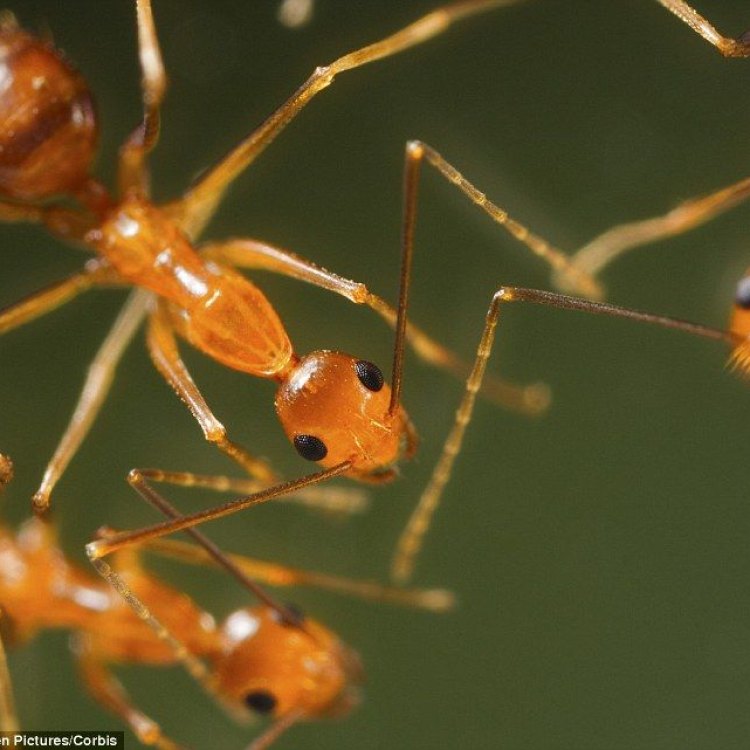
Anoplolepis gracilipes
The Tiny Menace: Yellow Crazy Ants and their Impact on Ecosystems
In the world of ants, there is one species that stands out for its unique and fascinating traits - the Yellow Crazy Ant (Anoplolepis gracilipes). These ants, also known as the "long-legged ant" or "African big-headed ant," are native to Africa but have made their way to other parts of the world, causing havoc wherever they go.But what makes this ant species so intriguing? In this article, we will explore the unique features and behaviors of Yellow Crazy Ants and the impact they have on ecosystems.
The Size and Lifespan of Yellow Crazy Ants
Measuring only 2 PeaceOfAnimals.Com.5-6 mm in size, Yellow Crazy Ants may not seem like a threatening species. However, their small size makes it easy for them to be transported to new areas, leading to their rapid spread across the globe. These ants have been found in various regions, including Australia, Hawaii, and the Seychelles.The average lifespan of a Yellow Crazy Ant is 1 to 3 years, during which they can cause significant damage to their environment.
Reproduction and Colony Formation
One of the unique features of Yellow Crazy Ants is their mode of reproduction. They mainly reproduce through queens laying eggs, but they also have a method called "budding." Budding is a process where new colonies are established by the queens leaving their original colony and taking some workers and brood (immature ants) with them to start a new colony.This method of reproduction makes it easy for the ants to spread and establish new colonies quickly, increasing their population and dominance in an area.
Behavior and Threats
Yellow Crazy Ants are highly social insects, forming large colonies that can contain up to 2 million individuals Yakutian Laika. In such large numbers, these ants can be quite aggressive and territorial. They can often be observed moving frenziedly in chaotic patterns, hence the name "crazy" ants.Their aggressive behavior can lead to the displacement of native ant species, creating a severe imbalance in the ecosystem. These ants can also cause ecological disturbance, affecting the natural biodiversity of an area. As invasive species, they do not have any natural predators in their new habitats, making them a major threat to their environment.
Distinctive Features and Interesting Facts
One of the most distinctive features of Yellow Crazy Ants is their fast movement. These ants can cover a large distance in a short time, making it challenging to eradicate them once they have established a colony in an area. This factor, along with their high numbers, makes them a formidable opponent to native ant species and other invertebrates.Another interesting fact about Yellow Crazy Ants is that they can cause significant damage to ecosystems. They have been known to disrupt the natural balance of an area by preying on native insects and invertebrates. Their presence can also lead to a decrease in plant diversity, affecting the food web and overall health of the ecosystem.
Human Use and Conservation Status
Unlike many other ant species, Yellow Crazy Ants do not have any human use. They are not used in traditional medicine or consumed as food, making them solely a nuisance for humans.Interestingly, despite their invasive nature, Yellow Crazy Ants are not evaluated for their conservation status. This could be due to their widespread presence and lack of understanding of their impact on ecosystems.
Predators and Migration Patterns
Yellow Crazy Ants are not top predators, but they can prey on small insects and invertebrates. While they do not have any major natural predators, some animals, such as birds and lizards, have been observed feeding on them in certain areas.Unlike some other ant species, Yellow Crazy Ants do not have a significant migration pattern. Once a colony is established, they tend to stay in the same area, continuously expanding their territory and dominating their environment.
In Conclusion
The Yellow Crazy Ant may be small in size, but its impact on ecosystems and biodiversity is significant. These ants spread quickly, disrupt the natural balance in their environment, and have no known beneficial use for humans. With their highly aggressive behavior and large numbers, they pose a threat to native ant species and other insects and invertebrates.It is essential to monitor the spread of Yellow Crazy Ants and take measures to control their population in invaded areas. By understanding their unique features and behaviors, we can work towards minimizing their negative impact on ecosystems and preserving the delicate balance of our natural world. So let us keep a watchful eye on these tiny but mighty creatures and take action before it's too late.
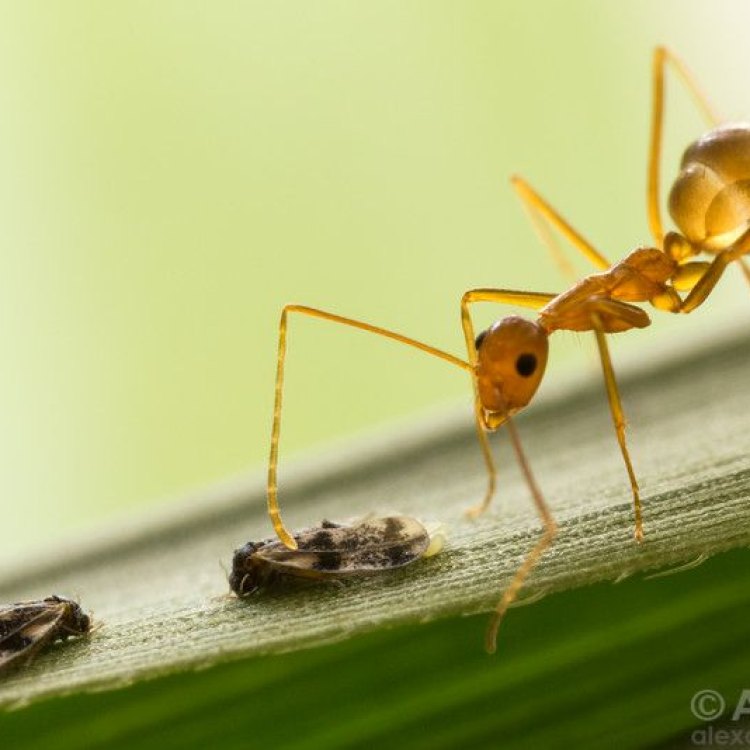
The Tiny But Formidable Yellow Crazy Ant: The Invasive Species That's Taking Over the World
Disclaimer: The content provided is for informational purposes only. We cannot guarantee the accuracy of the information on this page 100%. All information provided here may change without prior notice.

